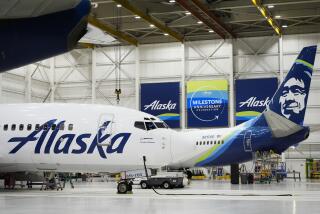Kin Find Little Comfort in TWA Notification Process
- Share via
WASHINGTON — There were no kindly knocks at the door or comforting telephone calls Wednesday night when Helen and Larry Siebert became, in the parlance of airline tragedies, “next of kin.”
Instead the Sieberts, of Jefferson City, Mo., learned of the fiery explosion of the TWA jumbo jet carrying their two children, Brenna and Chrisha, the way the rest of America did--on television. Then they drew their own conclusions about their daughters’ fate; it was not until an agonizing 12 hours later that the airline called with formal word that they had died.
In the harried hours after an airline crash, there is no more delicate task than the notification of next of kin, and there is no task more heavily criticized. In the wake of Wednesday’s explosion, as in the wake of crash after crash before it, questions are being raised about airline procedures for telling families their loved ones have perished.
In New York, Mayor Rudolph W. Giuliani, who lost a friend on TWA Flight 800, angrily criticized airline officials for being “outrageous and callous” in their treatment of families, saying he and other city officials had spent all night trying in vain to reach TWA executives.
But the airline, which did not begin its notification of families until 8 a.m. Thursday, disputed the mayor’s complaints. “These things take time,” a spokesman said.
Advocates for victims’ families, meanwhile, spent Thursday calling for uniform federal standards governing notification of next of kin. Some, like Victoria Cummock--whose husband was killed aboard Pan Am Flight 103 when it exploded over Lockerbie, Scotland, in 1988--are suggesting that independent third parties, such as the Red Cross, take over the notification procedures.
“The airline industry,” Cummock said on a CNN call-in show, “is the only industry where the victims’ families are placed in the hands of the people that killed them.”
Horror stories abound. Last month, a House subcommittee held a hearing on the notification process. There, Cummock told the committee of a man who learned about his daughter’s death from a message on his answering machine at home.
“This is Pan Am calling,” the message said, according to Cummock. “Your daughter, Diane, was on Pan Am Flight 103. The plane went down over Scotland. There were no survivors. If you have any questions, you may call us.”
A couple whose son died two years ago in the crash of an American Eagle plane testified that when they called a hotline, they were told an airline official would call back every 15 minutes until their son’s status could be confirmed. The phone calls never came.
In the wake of that hearing, the chairman of the subcommittee, Rep. John J. “Jimmy” Duncan Jr. (R-Tenn.) is drafting legislation that would give the National Transportation Safety Board greater control over the notification procedure. Currently, each airline has its own disaster plan; there are no federal requirements regarding notification.
Among the requirements the family advocates are seeking: immediate access to the airplane manifest, regardless of its accuracy; a reliable toll-free number for relatives to call. Notification in person--not by telephone--by someone trained in grief counseling, possibly a police officer or minister; printed material from the government, explaining the role of the NTSB and other agencies involved in investigating a crash; and better protection from reporters and personal-injury lawyers who congregate at the crash site.
“There needs to be more coordination between the airlines and the families and the government agencies,” said Jim Coon, a staff member for the committee. “We are trying to address that.”
For the airlines, the job of notifying next of kin is both painful and complex. “It’s probably one of the most impossible tasks anyone could ever be asked to do,” said Marcia Scott, a spokeswoman for ValuJet, which has generally received high marks for its notification of relatives after one of its jets crashed May 11 in the Florida Everglades.
Flight manifests must be verified--a job that can take hours or even days. Some passengers fly under assumed names. Children younger than 2 fly on their parents’ laps--”lap children,” the airlines call them--and may not be noted on flight lists.
“You’ve got so many families and so many victims; you have to have a very large team to be able to get to everybody very quickly,” said Agnes Huff, a former USAir official who now works as a crisis-management consultant in Los Angeles.
In a crash where there are survivors as well as victims, Huff said, the process is all the more complex. “If people walk away unscathed and go on to their next destination and you don’t have confirmation of them, there is that period of real distress for family members because they don’t know,” Huff said.
But in the case of a “non-survivable accident,” she said, relatives already “know in their hearts.”
Frank Capozza of Mendham, N.J., who put an 11-year-old French exchange student on the plane, was furious over long delays in notification.
“I think this is a terrible, terrible mistake,” Capozza said.
Giuliani, meanwhile, lashed out at the company for not immediately informing families that their loved ones had been lost. He said TWA officials promised him Wednesday night that they would be notified in a speedy manner.
Mark Abels, TWA vice president of communications, said the delay came about because company officials wanted to be certain the list was correct before notifying families.
“We’re certainly sorry that Mayor Giuliani has been disappointed with the notification process,” Abels said. “These things take time. . . . Everyone would like to be able to do it faster. But we are a little more interested in doing it right.”
Times staff writer Richard A. Serrano in New York contributed to this story.
More to Read
Sign up for Essential California
The most important California stories and recommendations in your inbox every morning.
You may occasionally receive promotional content from the Los Angeles Times.













